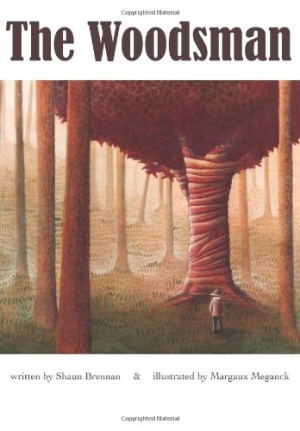
The Woodsman
Familiar yet worthy ideas on renewal, perseverance, and dedication permeate a story sure to appeal to parents who desire alternatives to the menace in Grimm tales.
Shaun Brennan debuts with a sober tale of honoring nature and memorializing family through art. Featuring a woodsman, his terminally ill son, and a dryad, The Woodsman captures traces of fairy tales and Greco-Roman mythology. The classic theme of devotion is enriched by Margaux Meganck’s outstanding illustrations, which highlight the story’s pivotal scenes while imbuing them with her own enchanting signature, from a misty, earth-toned palette to expressive figures.
The plot centers on a woodsman who cares for his ailing son and who searches for a Heart Tree in hopes of earning money. Unfolding with measured pacing and a fine sense for understated, dramatic developments, the story reveals how the woodsman finds the Heart Tree inhabited by a dryad. He agrees not to fell the tree and instead embarks on carving the dryad’s likeness with the help of his son, who is able to communicate with the “fey creature.”
Soon after dying, the son also becomes a Heart Tree, and the woodsman similarly carves his son’s image into its trunk. Like Baucis and Philemon, the dryad and son remain side by side, suggesting that a form of eternity may be possible when spirits twine with the earthbound.
Without explaining background details—including the dryad’s origins and how the son gained his unusual talent for seeing into a world beyond his father’s range—the story leaves ample room for magic. Grief never overwhelms; characters do not dwell on the unavoidable outcome, and the son’s death is treated as a peaceful transition. An emphasis on accepting change is exemplified by the dryad’s remark, “The days are filled with new experiences, and one should not live only in memory.”
Familiar yet worthy ideas on renewal, perseverance in art, and dedication permeate the story without becoming overt. Dialogue is also subtle and favors an almost formal cordiality. Among the stronger features is the glade in which the Heart Tree is found. Through Meganck’s soft-edged greenery, the glade exudes an appealing tranquility that suits the gentle story. The idyllic setting is further enhanced by names such as “Glowing Glen,” “Valley of Stars,” “Luminous River,” and “Cloud Cap Mountains.”
For parents who desire alternatives to the menace in Grimm tales, and for developing readers transitioning toward the higher word counts in chapter books, this is an attractively designed volume with an optimistic outlook.
Reviewed by
Karen Rigby
Disclosure: This article is not an endorsement, but a review. The publisher of this book provided free copies of the book and paid a small fee to have their book reviewed by a professional reviewer. Foreword Reviews and Clarion Reviews make no guarantee that the publisher will receive a positive review. Foreword Magazine, Inc. is disclosing this in accordance with the Federal Trade Commission’s 16 CFR, Part 255.
